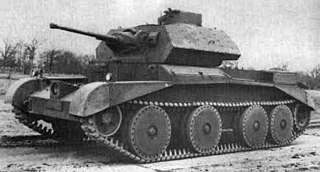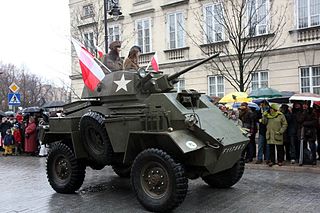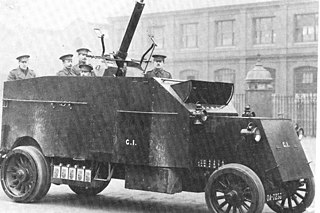
The Tank, Infantry, Mk III, Valentine was an infantry tank produced in the United Kingdom during World War II. More than 8,000 of the type were produced in eleven marks, plus various specialised variants, accounting for approximately a quarter of wartime British tank production. The many variants included riveted and welded construction, petrol and diesel engines and a progressive increase in armament. It was supplied in large numbers to the USSR and built under licence in Canada. It was used extensively by the British in the North African campaign. Developed by Vickers, it proved to be both strong and reliable.

The Leichter Panzerspähwagen was a series of light four-wheel drive armoured cars produced by Nazi Germany from 1935 to 1944.

The Combat Vehicle Reconnaissance (Tracked), abbreviated CVR(T), is a family of armoured fighting vehicles (AFV)s in service with the British Army and others throughout the world. They are small, highly mobile, air-transportable armoured vehicles designed to replace the Alvis Saladin armoured car.

The Cruiser Tank Mk IV was a British cruiser tank of the Second World War. It followed directly on from the Tank, Cruiser, Mk III. The first Mk IVs were Mk IIIs with extra armour fitted to the turret. Later Mk IVAs were built with the complete extra armour. The tank was used in France in 1940 and in the early part of the war in North Africa, before being withdrawn from service. A fast vehicle compared to other British tanks of the early part of the war, it was probably the best tank Britain had in 1940. In total, 955 of these tanks were built.

The Royal Canadian Armoured Corps is the armoured corps within the Canadian Army, including 3 Regular and 18 Reserve Force regiments as well as the Royal Canadian Armoured Corps School.

The FV603 Saracen is a six-wheeled armoured personnel carrier designed and produced by Alvis since 1952. It has been used by a variety of operators around the world, and is still in use in secondary roles in some countries. The Saracen became a recognisable vehicle as a result of its part in the policing of Northern Ireland as well as for its role in the South African government's enforcement of apartheid.

The Humber Armoured Car was one of the most widely produced British armoured cars of the Second World War. It supplemented the Humber Light Reconnaissance Car and remained in service until the end of the war.

AEC Armoured Car is the name of a series of British heavy armoured cars built by the Associated Equipment Company (AEC) during the Second World War.

The Light Tank Mark I to Mark V were a series of related designs of light tank produced by Vickers for the British Army during the interwar period.

The FV721 Fox Combat Vehicle Reconnaissance (Wheeled) was a 4 × 4 armoured car manufactured by ROF Leeds, deployed by the British Army as a replacement for the Ferret scout car and the Saladin armoured car. The Fox was introduced into service with B Squadron, 1st Royal Tank Regiment in 1975 and withdrawn from service 1993–94.

The Marmon-Herrington Armoured Car was a series of armoured vehicles that were produced in South Africa and adopted by the British Army during the Second World War. RAF Armoured Car companies possessed them, but seem never to have used them in action, making greater use of Rolls Royce Armoured Cars and other types.

The Vickers Medium Mark II was a British tank built by Vickers in the Inter-war period.

Armoured Carrier, Wheeled, Indian Pattern (ACV-IP), known also as Indian Pattern Carrier or other similar names, was an armoured car produced in India during the Second World War. It was typically armed with a Bren light machine gun. Those produced by Tata Locomotives were called "Tatanagars" after the location of the works. 4,655 were produced, used by Indian units in the Far East and Mediterranean and Middle East Theatre, typically in divisional reconnaissance regiments.

The Humber Light Reconnaissance Car, also known as Humberette or Ironside, was a British armoured car produced during the Second World War.

The Guy Armoured Carwas a British armoured car produced in limited numbers during Second World War. The car saw limited action during the Battle of France.

The Lanchester armoured car was a British armoured car built on the chassis of the Lanchester "Sporting Forty", it saw wide service with the Royal Naval Air Service and British Army during the First World War. The Lanchester was the second most numerous World War I armoured car in British service after the Rolls-Royce armoured car.
Tanks of the Second World War

Throughout its history, the Irish Army has used a number of armoured fighting vehicles.

The Pierce-Arrow armoured AA lorry was a self-propelled anti-aircraft carrier mounting a QF 2-pounder AA "pom-pom" gun, it was used by the Royal Marine Artillery during the First World War.

The Talbot armoured car was a British armoured car built on the chassis of a Clément-Talbot tourer. Built in small numbers to several patterns, the Talbot armoured cars saw service with the Royal Naval Air Service (R.N.A.S.) in the early years of the First World War, serving alongside Rolls-Royce and Delaunay-Belleville armoured cars.




















